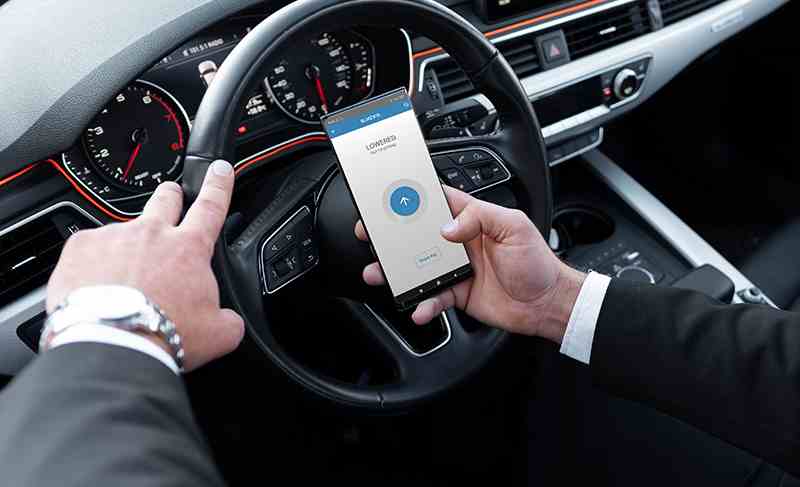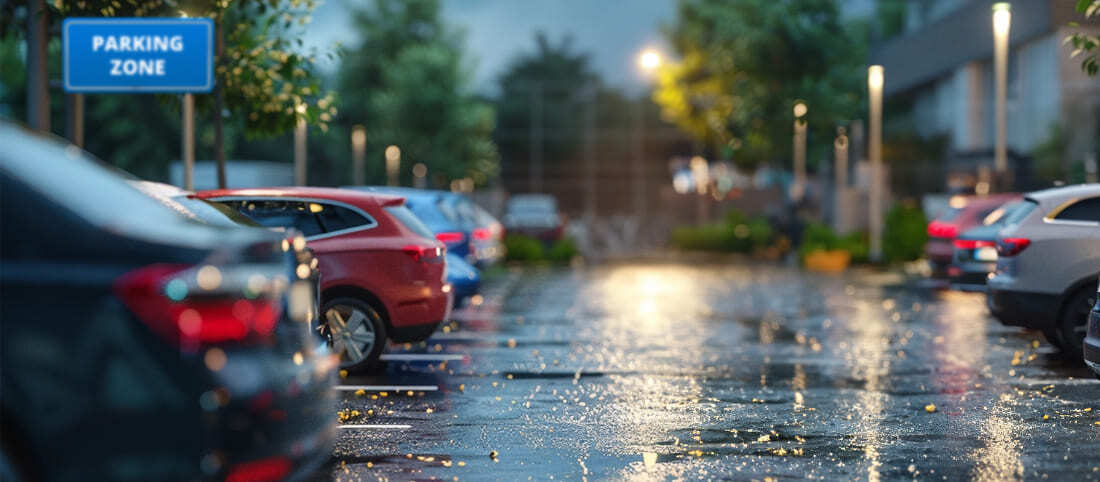Emerging trends that will determine the future of parking

Technology is changing the way we do almost everything, so why should parking be any different? How are new technological breakthroughs affecting the parking industry? Are these changes for the better, and how will they alter the way we park in the future? Read on to find out what comes next in the world of parking technology.
Table of contents:
Parking industry trends across the globe
Finding a parking space is one of the most stressful aspects of driving in a city, but new technologies are making it much easier. Parking innovations are emerging all over the globe, and they're getting more sophisticated too. Let's take a look at some of the most interesting parking industry trends across the globe.
Automated Parking with Sensor or Cameras
Automated parking is the initial step towards smart parking. Automatic gates allow vehicles to pass through without pausing at an attendant booth or other human-controlled entrance point. Instead, when the car approaches, sensors or cameras identify it, and the gate opens.
Camera-based technology uses the ANPR (Automatic Number Plate Recognition) system to recognize the license plates of vehicles entering and exiting parking lots. The camera not only identifies license plates, but it can also match them with a database of cars that have been approved for admission—which means you have complete control over who gets access to your space!
Sensor-based technology is similar, but instead of cameras, it uses sensors to detect vehicles approaching the gate. It's not as simple to install as camera-based systems because it relies on expensive hardware, which can be difficult to install in existing structures.
Aside from being more efficient than traditional methods, automated parking provides the following advantages:
- faster access time
- less congestion
- easier management
- lower costs
Parking as a service (PaaS)
Parking-as-a-Service is a revolutionary new parking approach. It is a mix of the most recent parking hardware and software, delivered as a subscription service model aimed at providing parking owners and operators with the most recent technology and services. But it goes even beyond that. It includes installation as well as regular hardware and software maintenance, support, and upgrades for the length of the contract.
Another advantage of PaaS is that it can provide real-time data analytics and reporting, allowing parking owners and operators to make informed decisions about their facilities. With access to this data, they can identify underutilized parking spaces, optimize pricing and revenue, and improve overall efficiency.
PaaS can be employed in any parking facility, whether it is single-story or multi-story, public or private, on-street or off-street. It's a flexible, cost-effective, and efficient way to manage parking facilities that provides customers with an exceptional user experience.
Also read: How To Make Your Parking Lot Smart & Modern
Smart parking solutions using the Internet of Things (IoT)
The Internet of Things (IoT) has been called the "Fourth Industrial Revolution." It is a term used to describe the growing number of smart devices that are connected to the internet and are able to communicate with each other. The IoT allows devices to collect and exchange data among themselves as well as with people (through applications, for example).
Smart parking management systems are one of the most fascinating IoT applications. The secret to success lies in the data:
- Parking managers can improve efficiency, reduce costs, and optimize revenue by collecting data on parking usage, occupancy rates, and pricing. They can adjust rates based on demand, identify high-traffic areas, and optimize parking layouts to maximize space utilization.
- Innovative cities across the globe can improve the efficiency of their parking systems, making it simpler to locate and pay for a parking space.
- Drivers can make better judgments about where and when to park, particularly when visiting congested regions such as airports or city centers during rush hour.
The IoT technology has already proven useful in other industries as well, and it's only getting better as new solutions emerge every day.
Also read: Top 10 Parking Management Systems (2023) Review Guide

Contactless Payment and Parking Apps
Contactless payment and parking apps are among the most popular developments in the parking sector, and they are rapidly expanding around the world. The convenience factor is what makes them so successful. The ability to use your smartphone to find a parking spot, pay for it or even control access to a parking lot certainly beats the outdated methods we have been using for decades.
As technology continues to advance, so does the ability of developers to create new features for parking apps. Customers like the simplicity and safety of contactless payments and pre-trip planning that parking applications enable. The in-advance reservations help people save time and money on their daily commute as well as provide valuable information about available spots in certain areas during peak hours when there is a heavy demand for them.
Another benefit of these apps is that they can be used as a universal solution that works across multiple platforms, such as Android devices or Apple iPhones without any problems at all, so you don't have to worry about compatibility issues when downloading one of these apps from an online store like App Store or Google Play Store.
Mobility Hubs
Mobility hubs are an important aspect of our future transportation systems, where people have access to a variety of sustainable transportation options that can help them get around more conveniently and reduce their environmental footprint. They can be found in city centers, major transit stations, or airports. They also provide parking spaces for cars and bikes, as well as charging stations for electric cars. In addition to offering these types of services and amenities, mobility hubs also often provide other useful services such as car sharing options, free public Wi-Fi, information about local events and community happenings, and even retail possibilities such as cafés and convenience shops, in addition to these sorts of services and amenities.
One of the earliest mobility hubs, the Park & Ride Systems, were first introduced in Europe in the 1960s. These systems allowed users to park their cars in a central location and then take public transit to their destination. They remain popular in many American and European cities today, serving as hubs for different forms of sustainable mobility such as car-sharing and bike-sharing programs, enabling commuters to easily transition from private vehicles to more sustainable forms of transport.
Mobility hubs' main objectives are:
- improving mobility in urban areas by reducing congestion on the roads
- lowering pollution by reducing the number of cars on the road
- encouraging people to choose public transport so they can save money and spend less time sitting in traffic
- providing an attractive alternative for residents looking for convenient ways of getting around their city.
Mobility hubs are a great example of what smart urban planning can accomplish. With growing concerns about environmental sustainability and the impact of cars on congestion and air pollution, many urban planners and transportation experts are now looking for ways to make it easier and more convenient for people to get around without relying on cars, which is why mobility hubs will only grow in popularity.
Also read: 5 urban parking problems and their smart solutions

Autonomous vehicles
The automotive world has changed dramatically over the past few years. Self-driving vehicles are still in their early stages, but they are gaining popularity. If you own or operate a parking lot, you should start thinking about how autonomous cars could affect your business.
Should autonomous driverless vehicles become prevalent, you will no longer need to endlessly circle around searching for a vacant spot. Self-driving vehicles will seamlessly drop you off at your destination and autonomously find parking. This will have a significant influence on parking design and operations, as well as the way we drive in general. Parking bays for autonomous vehicles will be smaller and more compact because there is no need for space to open car doors. This will reduce the amount of space needed in car parks and may allow you to fit more spaces into the same space as before.
In fact, the researchers created a computer model to investigate the effects of various parking lot layouts for self-driving vehicles, and they discovered that such spaces can house 62 to 87 percent more cars than normal lots. Because of this more effective use of space, fewer parking lots may be required, freeing up more urban space.
In addition to these changes, there are many other benefits that autonomous vehicle technology brings, including reducing road accidents caused by human errors, saving time spent driving and searching for a place to park, reducing pollution from cars, and lowering insurance costs.
From a product-oriented to a service-oriented industry
Historically, parking has been viewed as an element of transportation and not as a service. However, the parking industry is steadily transitioning from a product-oriented to a service-oriented industry. The shift can be attributed to several factors that include the evolution of parking technology, the development of innovative parking solutions, the increased use of mobile apps for booking, tracking, and paying for parking spaces, as well as increased customer expectations.
Benefits to citizens and businesses
As a result of this shift towards service, citizens and businesses alike are benefiting from more efficient systems that allow for convenience and ease of use.
For businesses, new parking technologies also offer significant financial benefits. By reducing the operational costs associated with traditional car park management, such as staff, maintenance, and infrastructure costs, businesses can free up resources to invest in other areas of their operations. Furthermore, better parking facilities can help attract more customers and improve customer satisfaction, resulting in increased revenue and profitability.
For citizens, the benefits are also clear: they gain more time in their day while simultaneously reducing stress levels associated with searching for a place to park. When parking becomes easier and less stressful, people are more likely to enjoy their time spent at home or at work. This can lead to improved productivity levels, as well as higher levels of customer satisfaction.
Benefits to the environment
The benefits for the environment are vast. From CO2 emissions and noise pollution to the amount of time spent idling, smart parking technology has the ability to make a real difference in how much your car contributes to the environment. It’s important to acknowledge the potential that smart parking solutions have to improve not only city livability in terms of convenience but also the long-term healthiness of our living environment.
As technology advances, we can expect to see more cities adopt the smart parking concept to improve the efficiency of their transportation systems and reduce their carbon footprint.

Technology is playing a key role
There is no doubt that the future of parking is smart, sustainable, and connected. It is being shaped by new technologies that are quickly becoming a big part of the transportation network. Evidence shows that these changes will benefit more than just the parking sector; they will benefit society as a whole. This technology will allow cities to manage their parking spaces more effectively and reduce congestion, with greater utilization of the transportation network and a lower need for new infrastructure. Decongestion and more efficient mobility will be enabled by IoT technology that communicates across networks, leading to parking assets that deliver excellent value to passengers via additional services and smart parking at the precise moment of need. To maintain their competitive edge, parking management companies and car park owners must embrace emerging technologies. So, don't get left behind. Contact us today to learn more about how Parklio's technology can help you improve your parking operations and deliver superior value to your customers.


